User:Jules/opticsofdatatransmission
“Our best machines are made of sunshine; they are all light and clean because they are nothing but signals, electromagnetic waves, a section of a spectrum, and these machines are eminently portable, mobile – a matter of immense human pain in Detroit and Singapore.”
Donna haraway – A Cyborg Manifesto, 1983
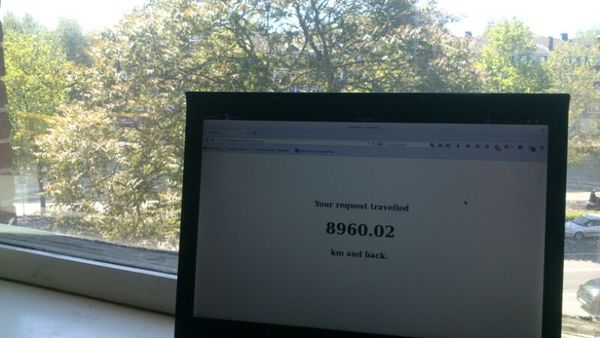
From home, I am 8 960.02 km far from my virtual server.
At human walking pace (5km/hour), it would take about 1792.004 hours or 74.66 days to get to the content of my page. Google Maps (sponsored plane search) evaluates it around 15 hours.
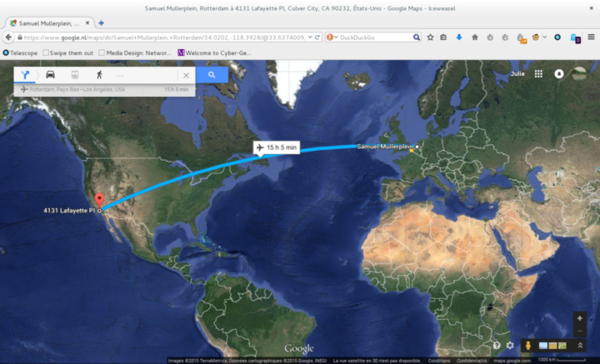
Last week-end I went to the exhibition entitled “Glass, engine of progress”[1] which is part of a series of exhibition on materials held at Het Nieuwe Instituut. The exhibition retraces how this very old man-made material enhanced scientific discovery and progress. The display addresses the questions of design and engineering, compiling a wide range of applications and transformations. It was very thought provoking, especially as glass is a material of transparency which can make things visible, a conveyor of light, a perfect container for chemicals and more generally a material we look through but not so much at.
Inevitably there was mention of using fibre optics for the transmission of data as light signals. So I decided to read a bit on the topic and came to wonder if the future of data transmission technology may indeed reside in the light but rather instead travelling through air. Glass may remain the medium for emission of light but it slows down the speed of light in comparison with air.[2]
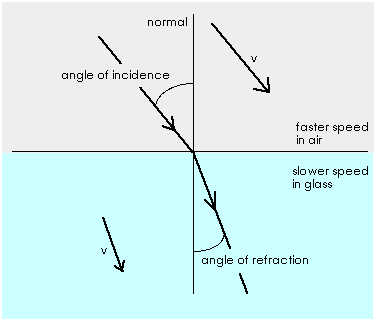
Light speed is around 299 792,458 km / s (in vacuum), which means that at light speed my personal web page would be displayed in 0.03s on my computer. (taking into account that my computer is in Rotterdam right now). This is obviously a bit misleading since there is no direct cabling between the server and my home.
Channels of lower physical density
In normal optical fibres, made of silica glass, light travels about 30% slower, or 200 000km/h. In 2013, Researchers at the University of Southampton developed a "hollow-core photonic-bandgap fibre". Basically that means that they have replaced glass with air.
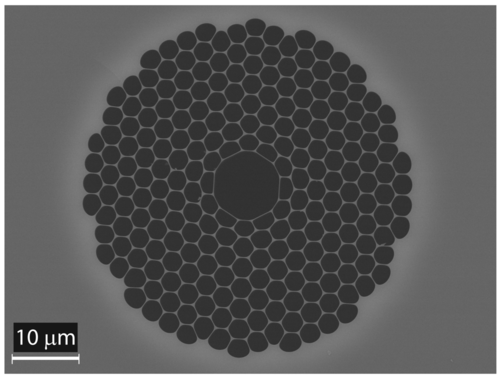
They claimed that this could achieve data transmission at close to (99.7%) the speed of light in vacuum.[3] Also this fibre would provide with "low loss (3.5 dB km−1) and wide bandwidth (160 nm), and use it to transmit 37 × 40 Gbit s−1 channels at a 1.54 µs km−1 faster speed than in a conventional fibre". Indeed the routing may slow down those ideal calculations. Interestingly the abstract of the report mentions that this discovery could be important for "the development of future exaflop-scale supercomputers, financial algorithmic trading and cloud computing". With those application purposes in mind, that would mean that the pace of economical fluctuations, scientific calculations, data transfer from the cloud to whatever device, would increase by about 30%. All that would happen thanks to light being carried through the air.
Light Fidelity
Another related technological development is the notorious Li-Fi. While Wi-Fi relies on Gigahertz radio waves, Wi-Fi uses visible light communication. Compared to Wi-Fi, it would not suffer to disturbances, and Li-Fi could also solve the radio Frequency bandwidth shortage.
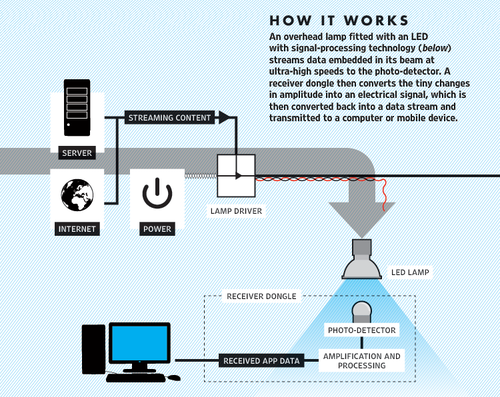
The technology is based on flickering LED on one hand and a light sensor on the other. It is restricted by line of sight, which means that logically it wouldn't leak outside the room where you stand. There is a very wide range of potential applications and the consequence could be a more omnipresent Network (airplanes, underwater, through street lamp posts).
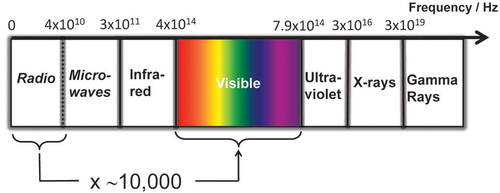
On the electromagnetric spectrum we can see visible light has a huge length
It would be about 10 times faster than Wi-Fi. When Harold Haas, gave a TED presentation[4]. It is possible that in the future it would speed up to 500 mbps.[5]
Here is a selection of quotes from Harold Haas as he was going through his epiphany. The rhetoric is quite interesting since it naturalises the technology a lot:
- […] Wireless communication has become a utility like electricity and water. We use it every day, we use it in our lives [..]it is because of this importance that I decided to look into the issues that this technology has because it is so fundamental to our lives.
- Light has been around for many millions of years and in fact it has created us, it has created life it has created all stuff of life. So it's inherently safe to use. So wouldn't it be great to use it for wireless communications?
- if the whole world would deploy them you would save a hundted of power plants, that's fact. And then I've mentioned the availability, you will agree with me that you have lights in the hospitals, you have lights in an aircraft, so it is everywhere where there is light, look around you it's everywhere.
- ↑ http://glas.hetnieuweinstituut.nl/en
- ↑ See index of refraction of light in common materials
http://www.rpi.edu/dept/phys/Dept2/APPhys1/optics/optics/node4.html - ↑ http://www.nature.com/nphoton/journal/v7/n4/full/nphoton.2013.45.html
- ↑ https://www.youtube.com/watch?v=NaoSp4NpkGg
- ↑ http://www.ripublication.com/irph/ijict_spl/ijictv4n16spl_11.pdf
